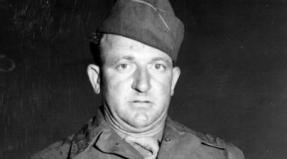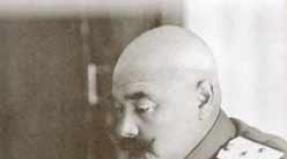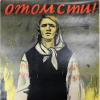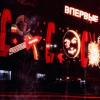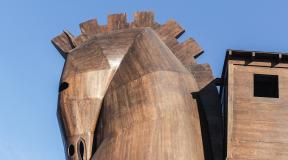What a combustible mixture the Byzantines burned the boats of the Rus. "Greek fire" is the secret weapon of the Byzantine empire. Some kind of wonderful fire, like lightning from heaven
In the year 6449 (941). Igor went to the Greeks. And the Bulgarians sent a message to the Tsar that the Russians were going to Constantinople: ten thousand ships. And they came, and swam, and began to plunder the land of Bithynia, and captive the land along the Pontic Sea to Heraclius and to the Paphlagon land, and captivated the whole country of Nicomedia, and burned the whole Judgment. And whoever was captured, they crucified some, while in others, as the target was set, they shot arrows, wringing their hands back, tied and hammered iron nails into their heads. Many holy churches were also burnt and seized a lot of wealth on both banks of the Court. When the warriors came from the east - Panfir-Demestik with forty thousand, Phoca-patrician with the Macedonians, Fedor-Stratilat with the Thracians, and the noble boyars with them, they surrounded Russia. The Russians, having consulted, went out against the Greeks with weapons, and in a fierce battle they barely defeated the Greeks. In the evening the Russians returned to their squad, and at night, having sat down in boats, sailed away. Theophanes met them in boats with fire and began to fire trumpets on the Russian boats. And a terrible miracle was seen. The Russians, seeing the flames, threw themselves into the sea water, trying to escape, and so the rest returned home. And, having come to their land, they told - each to his own - about what had happened and about the rook fire. “As if the lightning from heaven,” they said, “have the Greeks, and letting it go, they burned us; that's why they did not overcome them. " Igor, returning, began to gather a multitude of soldiers and sent across the sea to the Varangians, inviting them to the Greeks, again intending to march against them.
SOME WONDERFUL FIRE, EXACTLY HEAVENLY LIGHTNING
The chronicler knows the Russian legend and the Greek news about Igor's campaign against Constantinople: in 941 the Russian prince went by sea to the shores of the Empire, the Bulgarians gave news to Constantinople that Russia was coming; the protovestiary Theophanes was sent against her, who burned Igor's boats with Greek fire. Having suffered defeat at sea, the Russians landed on the shores of Asia Minor and, according to custom, severely devastated them, but here they were caught and defeated by Patrician Bardoi and the domesticated John, threw themselves into boats and set off to the shores of Thrace, on the road they were overtaken, again defeated by Theophanes and with the small the remnants returned back to Russia. At home, the fugitives justified themselves by the fact that the Greeks had some kind of wonderful fire, like lightning from heaven, which they let on Russian boats and burned them.
But on the dry road, what was the reason for their defeat? This reason can be discovered in the legend itself, from which it is clear that Igor's campaign was not like Oleg's undertaking, accomplished by the united forces of many tribes; it was rather a raid by a gang, a small squad. That the troops were small, and contemporaries attributed the reason for the failure to this circumstance, show the words of the chronicler, who immediately after describing the campaign says that Igor, having come home, began to gather a large army, sent across the sea to hire the Varangians to go back to the Empire.
The chronicler places Igor's second campaign against the Greeks under the year 944; this time he says that Igor, like Oleg, gathered a lot of troops: Varangians, Rus, Glades, Slavs, Krivichi, Tivertsy, hired the Pechenegs, taking hostages from them, and set out on a campaign on boats and horses to avenge the previous defeat ... The Korsunians sent a message to the Emperor Roman: "Russia is coming with countless ships, ships have covered the entire sea." The Bulgarians also sent a message: “Rus is coming; hired the Pechenegs as well. " Then, according to legend, the emperor sent his best boyars to Igor with a request: "Do not go, but take the tribute that Oleg took, and I will give it to her." The emperor also sent expensive fabrics and a lot of gold to the Pechenegs. Igor, having reached the Danube, summoned a squad and began to think with it about the proposals of the imperial; the squad said: “If the king says so, then why do we have more? Without beating, let's take gold, silver and paolok! Who knows who will prevail, us or them? After all, it is impossible to agree with the sea in advance, we do not walk on the land, but in the depth of the sea, one death for all. " Igor obeyed the squad, ordered the Pechenegs to fight the Bulgarian land, took gold and pavoloks from the Greeks for himself and for the entire army, and went back to Kiev. In the next year, 945, a treaty was concluded with the Greeks, also, apparently, to confirm the brief and, perhaps, oral efforts made immediately after the end of the campaign.
KIEV - CAPITAL, RULER - IGOR
In Igor's agreement with the Greeks, we read, by the way, that the Russian Grand Duke and his boyars can annually send as many ships to the great Greek kings as they want, with ambassadors and guests, that is, with their own clerks and with free Russian merchants. This story of the Byzantine emperor clearly shows us the close connection between the annual turnover of the political and economic life of Russia. The tribute that the Kiev prince collected as a ruler was at the same time the material of his trade turnover: having become a sovereign, like a Koning, he, like a Varangian, did not cease to be an armed merchant. He shared tribute with his retinue, which served him as an instrument of government, constituted the government class. This class acted as the main lever, in both ways, both politically and economically: in the winter it ruled, walked around the people, begged, and in the summer it traded in what it collected during the winter. The same story by Constantine vividly outlines the centralizing significance of Kiev as the focus of the political and economic life of the Russian land. Russia, the government class with a prince at its head, supported by its overseas trade turnover in the Slavic population of the entire Dnieper basin the ship industry, which found a sale at the spring fair of one-tree trees near Kiev, and every spring it pulled merchant boats here from different corners of the country along the Greek-Varangian route with goods of forest animals and bee keepers. With such a complex economic cycle, a silver Arabian dirgem or a gold fastener of Byzantine work fell from Baghdad or Constantinople to the banks of the Oka or Vazuz, where archaeologists find them.
SWEATED BY PERUN
It is remarkable that the Varangian (Germanic) mythology did not have any influence on the Slavic, despite the political domination of the Varangians; this was for the reason that the pagan beliefs of the Varangians were neither clearer nor stronger than the Slavic: the Varangians very easily changed their paganism to the Slavic cult, if they did not accept Greek Christianity. Prince Igor, a Varangian by birth, and his Varangian squad already swore by the Slavic Perun and worshiped his idol.
"DON'T GO BUT TAKE A Tribute"
One of the reasons for the catastrophic defeat of the "king" Helg and Prince Igor in 941 was that they could not find allies for the war with Byzantium. Khazaria was absorbed in the struggle with the Pechenegs and could not provide effective assistance to the Russians.
In 944 the Kiev prince Igor undertook a second campaign against Constantinople. The Kiev chronicler did not find any mention of this enterprise in Byzantine sources, and in order to describe the new military expedition, he had to "paraphrase" the story of the first campaign.
Igor did not manage to catch the Greeks by surprise. The Korsunians and Bulgarians managed to warn Constantinople about the danger. The emperor sent "the best boyars" to Igor, begging him: "Do not go, but take a tribute, I will also give Oleg to that tribute." Taking advantage of this, Igor accepted the tribute and left "in his own way." The chronicler was sure that the Greeks were frightened by the power of the Russian fleet, for Igor's ships covered the whole sea "beschisla". In fact, the Byzantines were worried not so much by the Rus fleet, about the recent defeat of which they had not forgotten, as by Igor's alliance with the Pechenezh Horde. The nomad camps of the Pechenezhskaya horde spread over a vast area from the Lower Don to the Dnieper. The Pechenegs became the dominant power in the Black Sea region. According to Konstantin Porphyrogenitus, the attacks of the Pechenegs deprived the Russians of the opportunity to fight with Byzantium. The peace between the Pechenegs and the Rus was fraught with a threat to the empire.
Preparing for the war with Byzantium, the Kiev prince "hired" the Pechenegs, ie. He sent rich gifts to their leaders, and took from them the "Tali" - hostages. Having received tribute from the emperor, the Rus sailed to the east, but first Igor "ordered the Pechenegs to fight the Bulgarian land." The Pechenegs were pushed to the war against the Bulgarians, perhaps, not only by the Rus, but also by the Greeks. Byzantium did not abandon its intention to weaken Bulgaria and re-subordinate it to its rule. After completing the hostilities, the Russians and the Greeks exchanged embassies and concluded a peace treaty. It follows from the agreement that the Crimea was the sphere of special interests of Byzantium and Rus. The situation on the Crimean peninsula was determined by two factors: the old Byzantine-Khazar conflict and the emergence of the Norman principality at the junction of the Byzantine and Khazar possessions. Chersonesos (Korsun) remained the main stronghold of the empire in the Crimea. The Russian prince was forbidden to "have volosts", that is, to seize the possessions of the Khazars in the Crimea. Moreover, the treaty obliged the Russian prince to fight ("yes fight") with the enemies of Byzantium in the Crimea. If “that country” (the Khazar possessions) does not submit, in this case the emperor promised to send his troops to help the Russians. In fact, Byzantium set a goal to expel the Khazars from the Crimea by the hands of the Rus, and then divide them from the possession. The agreement was implemented, albeit with a delay of more than half a century. The Kiev principality got Tmutarakan with the cities of Tamatarkha and Kerch, and Byzantium conquered the last possessions of the Khazars approximately in the Surozh region. The Byzantines were directly assisted by King Sfeng, the uncle of the Kiev prince ...
Peace treaties with the Greeks created favorable conditions for the development of trade and diplomatic relations between Kievan Rus and Byzantium. The Rus were given the right to equip any number of ships and trade in the markets of Constantinople. Oleg had to agree that the Rus, no matter how many of them came to Byzantium, have the right to enter the service in the imperial army without any permission of the Kiev prince ...
Peace treaties created conditions for the penetration of Christian ideas into Russia. At the conclusion of the 911 treaty, there was not a single Christian among Oleg's ambassadors. The Rus sealed with a "haraty" oath to Perun. In 944, in addition to the pagan Rus, the Christian Rus also participated in the negotiations with the Greeks. The Byzantines singled them out, giving them the right to be the first to take the oath and taking them to the "cathedral church" - the Sophia Cathedral.
The study of the text of the treaty allowed M.D. Priselkov to assume that already under Igor, power in Kiev actually belonged to the Christian party, to which the prince himself belonged, and that the negotiations in Constantinople led to the development of conditions for the establishment of a new faith in Kiev. This assumption cannot be reconciled with the source. One of the important articles of the treaty of 944 read: "If a Christian will kill a Rusyn, or a Rusyn will kill a Christian," and so on. Russian ambassadors lived in Constantinople for a long time: they had to sell the goods they brought. The Greeks used this circumstance to convert some of them to Christianity ... The agreement of 944, drawn up by experienced Byzantine diplomats, provided for the possibility of the adoption of Christianity by the "princes" who remained during the negotiations in Kiev. The final formula read: “And whoever transgresses (agreement - R.S.) from our country (Rus. - R.S.), whether the prince, or who, whether baptized unbaptized, but they do not have help from God .. . "; violated the agreement "let there be an oath from God and from Perun."
Skrynnikov R.G. Old Russian state
THE TOP OF ANCIENT RUSSIAN DIPLOMACY
But what is amazing! This time Russia insisted - and it is difficult to find another word here - on the appearance of Byzantine ambassadors in Kiev. The band of discrimination of the northern "barbarians" ended, who, despite their high-profile victories, obediently wandered to Constantinople for negotiations and here, under the watchful eyes of the Byzantine clerks, formulated their contractual requirements, put their speeches on paper, diligently translated from Greek diplomatic stereotypes unfamiliar to them, and then they gazed in fascination at the splendor of the Constantinople temples and palaces.
Now the Byzantine ambassadors had to appear for the first negotiations in Kiev, and it is difficult to overestimate the importance, all the prestige of the agreement reached. ...
In fact, the tangle of the entire Eastern European politics of those days was unwound here, in which Russia, Byzantium, Bulgaria, Hungary, the Pechenegs and, possibly, Khazaria were involved. Negotiations took place here, new diplomatic stereotypes were developed, the foundation was laid for a new long-term agreement with the empire, which was supposed to regulate relations between countries, reconcile or at least smooth out the contradictions between them ...
And only then the Russian ambassadors moved to Constantinople.
It was a big embassy. Gone are the days when the five Russian ambassadors opposed the entire Byzantine diplomatic routine. Now a prestigious representation of a powerful state was sent to Constantinople, consisting of 51 people - 25 ambassadors and 26 merchants. They were accompanied by armed guards, shipbuilders ...
The title of the Russian Grand Duke Igor sounded differently in the new treaty. The epithet "bright", which, with such a far from naive calculation, was awarded to Oleg by the Byzantine clerks, was lost and disappeared somewhere. In Kiev, apparently, they very quickly figured out what was what and realized what an unenviable position he was putting the Kiev prince in. Now, in the treaty of 944, this title is not, but Igor is called here as in his homeland - "the Russian Grand Duke." True, sometimes in articles, so to speak, the concepts of "grand duke" and "prince" are used in working order. And yet it is quite obvious that Russia tried to achieve change here and insisted on the title that did not infringe on its state dignity, although, of course, it was still far from such heights as the "tsar" and the emperor "...
Russia, step by step, slowly and stubbornly, won diplomatic positions for itself. But this was especially vividly reflected in the procedure for signing and approving the agreement, as stated in the agreement. This text is so remarkable that there is a temptation to quote it in its entirety ...
For the first time we see that the treaty was signed by the Byzantine emperors, for the first time the Byzantine side was instructed by the treaty to send its representatives to Kiev again in order to take an oath on the treaty from the Russian Grand Duke and his husbands. For the first time, Russia and Byzantium assumed equal obligations regarding the approval of the treaty. Thus, from the beginning of the development of a new diplomatic document until the very end of this work, Russia stood on an equal footing with the empire, and this itself was already a remarkable phenomenon in the history of Eastern Europe.
And the agreement itself, which both parties worked out with such care, became an extraordinary event. The diplomacy of that time does not know a more ambitious, detailed document that embraces both economic, political, and military-allied relations between countries.
Information about the use of flamethrowing means dates back to antiquity. Then these technologies were borrowed by the Byzantine army. The Romans somehow set fire to the enemy fleet already in 618, during the siege of Constantinople, undertaken by the Avar kagan in alliance with the Iranian shah Khosrov II. The besiegers used the Slavic sea flotilla for the crossing, which was burned in the Golden Horn Bay.
A warrior with a manual flamethrower siphon. From the Vatican manuscript "Poliorketiki" by Heron of Byzantine(Codex Vaticanus Graecus 1605). IX-XI centuries
The inventor of the "Greek fire" was the Syrian engineer Kallinikos, a refugee from Heliopolis (present-day Baalbek in Lebanon) seized by the Arabs. In 673 he demonstrated his invention to the Vasileus Constantine IV and was hired.
It was truly a hellish weapon, from which there was no salvation: "liquid fire" burned even on water.
The basis of "liquid fire" was natural pure oil. Its exact recipe remains a secret to this day. However, the technology of using the combustible mixture was much more important. It was required to accurately determine the degree of heating of the hermetically sealed boiler and the force of pressure on the surface of the mixture of air, injected with the help of bellows. The boiler was connected to a special siphon, to the opening of which an open fire was brought up at the right moment, the boiler tap opened, and the flammable liquid, ignited, poured out onto enemy ships or siege vehicles. Siphons were usually made of bronze. The length of the fiery jet emitted by them did not exceed 25 meters.
Siphon for "Greek fire"
Oil for the "liquid fire" was also mined in the Northern Black Sea and Azov regions, where archaeologists find in abundance shards from Byzantine amphorae with a resinous sediment on the walls. These amphoras served as containers for the transportation of oil, identical in chemical composition to the Kerch and Taman ones.
The invention of Kallinikos was tested in the same year 673, when with his help the Arab fleet was destroyed, which first laid siege to Constantinople. According to the Byzantine historian Theophanes, "the Arabs were shocked" and "fled in great fear."
Byzantine ship,armed with Greek fire, attacks the enemy.
Miniature from "Chronicle" of John Skilitsa (MS Graecus Vitr. 26-2). XII century Madrid, Spanish National Library
Since then, the "liquid fire" more than once rescued the capital of Byzantium and helped the Romans to win battles. Vasilevs Leo VI the Wise (866-912) proudly wrote: “We possess various means, both old and new, to destroy enemy ships and people fighting on them. This is the fire prepared for the siphons, from which it rushes with thunderous noise and smoke, burning the ships to which we direct it. "
The Rus first became acquainted with the action of "liquid fire" during the campaign against Constantinople of Prince Igor in 941. Then the capital of the Romeian state was besieged by a large Russian fleet - about two hundred and fifty boats. The city was blocked by land and sea. The Byzantine fleet at this time was far from the capital, fighting with Arab pirates in the Mediterranean. The Byzantine emperor Romanus I Lacapenus had only a dozen and a half ships at hand, written off to the shore due to dilapidation. Nevertheless, the basileus decided to give the Rus a battle. Siphons with "Greek fire" were installed on the half-rotted vessels.
Seeing the Greek ships, the Rus raised their sails and rushed to meet them. The Romans were waiting for them in the Golden Horn Bay.
The Rus boldly approached the Greek ships, intending to board them. Russian boats stuck around the ship of the Roman naval commander Theophanes, who was walking in front of the battle formation of the Greeks. At this moment, the wind suddenly died down, the sea was completely calm. Now the Greeks could use their flamethrowers without hindrance. The instantaneous change in the weather was perceived by them as help from above. Greek sailors and soldiers perked up. And now from the ship of Theophanes, surrounded by Russian boats, fiery streams poured in all directions. A flammable liquid has spilled over the water. The sea around the Russian ships seemed to suddenly flare up; several rooks blazed at once.
The action of the terrible weapon shook the Igor Warriors to the core. In an instant, all their courage disappeared, the Russians were seized by panic fear. “Seeing this,” writes a contemporary of events, Bishop Liutprand of Cremona, “the Russians immediately began to rush from ships into the sea, preferring to drown in the waves rather than burn up in flames. Others, burdened with shells and helmets, went to the bottom, and they were no longer seen, while some kept afloat burned even in the middle of the sea waves. " The Greek ships that arrived in time "completed the rout, sank many ships together with the crew, killed many, and took even more alive" (Theophanes' successor). Igor, as Leo the Deacon testifies, escaped "with hardly a dozen boats", which managed to land on the shore.
This is how our ancestors got to know what we now call the superiority of advanced technology.
"Olyadny" (oladiya in Old Russian, - boat, ship) fire for a long time became the talk of the town in Russia. The Life of Basil the New says that Russian soldiers returned to their homeland, "to tell what happened to them and what they suffered at the behest of God." The "Tale of Bygone Years" brought the living voices of these people scorched by fire to us: "Those who returned to their land told about what happened; and about the old fire they said that the Greeks had this lightning from heaven; and, letting it go, they burned us, and for this reason they did not overcome them. " These stories are indelibly engraved in the memory of the Russians. Leo the Deacon reports that even thirty years later, the soldiers of Svyatoslav still could not recall the liquid fire without trembling, since “they heard from their elders” that with this fire the Greeks had turned Igor's fleet into ashes.
View of Constantinople. Drawing from the Nuremberg Chronicle. 1493 g.
It took a whole century for the fear to be forgotten, and the Russian fleet again dared to approach the walls of Constantinople. This time it was the army of Prince Yaroslav the Wise, led by his son Vladimir.
In the second half of July 1043, the Russian flotilla entered the Bosphorus and occupied the harbor on the right bank of the strait, opposite the Golden Horn Bay, where, under the protection of heavy chains that blocked the entrance to the bay, the Romeian fleet stood at a standstill. On the same day, Vasilevs Constantine IX Monomakh ordered to prepare for battle all available naval forces - not only battle triremes, but also cargo ships, on which siphons with "liquid fire" were installed. Cavalry detachments were sent along the coast. Toward nightfall, the Basileus, according to the Byzantine chronicler Michael Psellus, solemnly announced to the Russians that tomorrow he intends to give them a sea battle.
With the first rays of the sun cutting through the morning fog, the inhabitants Byzantine capital saw hundreds of Russian boats, built in one line from coast to coast. “And there was no man among us,” says Psellus, “who looked at what was happening without the strongest emotional disturbance. I myself, standing near the autocrat (he was sitting on a hill sloping down to the sea), watched the events from afar. " Apparently, this terrifying sight made an impression on Constantine IX. Having ordered his fleet to line up in battle formation, he, however, hesitated in giving the signal to start the battle.
The painful hours dragged on in inactivity. Long ago noon had passed, and the chain of Russian boats was still swaying on the waves of the strait, waiting for the Roman ships to leave the bay. Only when the sun began to decline did the basileus, overcoming his indecision, finally ordered the master Vasily Theodorokan to leave the bay with two or three ships in order to drag the enemy into battle. “They swam forward easily and harmoniously,” says Psellus, “spearmen and stone throwers raised a battle cry on their decks, fire throwers took their places and prepared to act. But at this time, many barbarian boats, separated from the rest of the fleet, rushed to our ships at a high speed. Then the barbarians divided, surrounded each of the triremes from all sides and began to pierce the Roman ships from below with lances; ours at that time from above pelted them with stones and spears. When the fire flew at the enemy, which burned the eyes, some barbarians rushed into the sea to swim to their own, others completely despaired and could not figure out how to be saved. "
According to Skilitsa, Vasily Theodorokan burned 7 Russian boats, sank 3 together with people, and captured one by jumping into it with a weapon in his hands and engaging in battle with the Rus who were there, some of which were killed by him, the others rushed into the water.
Seeing the successful actions of the master, Constantine signaled the offensive to the entire Roman fleet. Fiery triremes, surrounded by smaller ships, escaped from the Golden Horn Bay and rushed to the Rus. The latter were obviously discouraged by the unexpectedly large size of the Roman squadron. Psellus recalls that "when the triremes crossed the sea and found themselves right next to the boats, the barbarian system collapsed, the chain broke, some ships dared to stay in place, but most of them fled."
In the gathering twilight, the bulk of the Russian boats left the Bosphorus Strait into the Black Sea, probably hoping to hide from pursuit in the coastal shallow water. Unfortunately, just at this time a strong east wind rose, which, according to Psellus, “rippled the sea with waves and drove the water ramparts against the barbarians. Some ships were immediately covered by the rearing waves, while others were dragged along the sea for a long time and then thrown onto the rocks and onto the steep bank; after some of them our triremes set off in pursuit, they launched some boats under the water together with the team, and other warriors with triremes made holes and, half-submerged, brought them to the nearest shore. Russian chronicles tell that the wind “smashed” the “prince's ship”, but the governor Ivan Tvorimirich, who came to the rescue, saved Vladimir by taking him into his boat. The rest of the warriors had to save themselves as best they could. Many of those who reached the coast died under the hooves of the Romeian cavalry that arrived in time. "And then they arranged a true bloodletting for the barbarians, - concludes his story Psellus - it seemed as if the stream of blood poured out of the rivers colored the sea."
Having ordered a piece of tinder to be tied to the birds, set it on fire and released the birds into the city. They flew to their nests and burned the city of the Drevlyans. Iskorosten fell. Olga imposed an exorbitant tribute on the surviving townspeople. For many years, the legend about the miraculous capture of the Drevlyansky fortress was passed down from generation to generation. The chronicler willingly included it in The Tale of Vengeance. Historians pass over this episode in silence. It is not surprising - the chronicle version raises a number of questions ...
In the first half of 946, the Kiev princess Olga set out on a campaign against the Drevlyans, who had killed her husband, Prince Igor, a year earlier. The troops took several Drevlyan fortresses. But Iskorosten (Korosten), the city of Prince Mal on the Uzh River, could not be conquered on the move. The protracted siege disintegrated the fighting spirit of the squad. The princess was also worried about the approaching autumn thaw. This prompted her to look for an extraordinary solution ...
Military stealth
A wise and great woman began peace negotiations. Surprised by her softness, the Drevlyans asked: “What do you want from us? We are glad to give you honey and furs. " But she replied: "Now you have neither honey, nor furs, so I ask you a little: give me three pigeons and three sparrows from each yard." Having given out to her soldiers some a pigeon, some a sparrow, she ordered to tie a small piece of tinder to each bird. And when it began to get dark, she ordered the tinder to be set on fire and the birds set free. They flew into their nests, and then dovecotes, cages, sheds and haylings broke out. And there was no courtyard where it would not burn ...
Iskorosten fell. Olga imposed an exorbitant tribute on the surviving townspeople. For many years, the legend about the miraculous capture of the Drevlyansky fortress was passed down from generation to generation. The chronicler willingly included it in The Tale of Vengeance. Historians pass over this episode in silence. It is not surprising - the chronicle version raises a number of questions.
Why did Olga wait for the approach of autumn, and did not apply the “bird version” much earlier? Why were the pigeons and sparrows released at nightfall? Why, finally, a bird carrying fire should fly headlong to its native nest?
What was hidden behind the mysterious burning birds? But what if Princess Olga used some mysterious weapon that possessed incredible power at that time? Is it possible?
Brahma's weapon
... A heated battle unfolded at the walls of the ancient city. The clanging of weapons and armor, the death moans of people and the neighing of fallen horses merged into one terrible cacophony. And in the middle of this raging sea of death, like moving cliffs, towered huge war elephants, crushing the doomed screaming with fear.
The scales hesitated. The defenders' troops wavered. The enemy pressed them to the open gates of the city. The last resort remained. The ruler, once again circling the battlefield, raised his hand, signaling to the priests. “Weapon of Brahma! Weapon of Brahma! " - a reverent whisper swept among those close to him.
Several people, dressed in black robes, carried out of the temple a long pointed object - a huge iron arrow. It was carefully placed on a special stone pedestal with a long polished chute.
The priests knelt down and, loudly shouting sacred words, called on the god Brahma to accurately direct the weapon at the enemies.
The elder priest was handed a torch mounted on a long bamboo pole. He waited for everyone to leave the platform, and, hiding behind a stone ledge, raised the torch to the iron arrow.
Like a thousand snakes, she hissed, like a thousand thousand hearths, exhaled the smoke, and with a roar like thunder, she leaped from her place. In a moment, the chariots were on fire. People, horses, elephants lay defeated, burned by a terrible explosion ...
What is it? Another fantasy tale of a war on another planet? No, the events described took place on Earth, apparently, almost three thousand years ago.
Historical monuments and chronicles of the past keep mention of an unusual weapon. Here is his description from the ancient Indian composition "Mahabharata". “A blazing projectile with the radiance of fire was fired. A thick fog suddenly covered the army. All sides of the horizon were plunged into darkness. Evil whirlwinds rose. The clouds roared into the sky ... It seemed that even the sun was spinning. The world, scorched by the heat of this weapon, was in a fever ... ". An impressive ancient story! And far from the only one.
According to the recipes of the ancient Greeks
... In 717, Theophanes in his "Chronography" talked about the capture of the Sideron fortress, located in the mountain pass between Tsebelda and Sukhumi. Spafari Leo laid siege to the fortress, but the location and strength of the fortifications did not allow them to seize it. The lion made an agreement with the defenders of the fortress, promising not to harm them, if only they would let him in with 30 soldiers. “But his words, - wrote Theophan, - Leo did not keep, but ordered his thirty companions:“ When we enter, seize the gate, and let everyone come in ”. As soon as this happened, the spafari ordered to throw fire in the direction of the fortress. A big fire broke out, and families began to go out, taking with them what they could only take from their property.
One of the eyewitnesses wrote that the incendiary mixture was thrown towards the enemy from special copper pipes. This sight caused horror and surprise to the enemy. The combustible mixture was applied to a metal spear launched by a giant sling. It flew with the speed of lightning and with a thunderous crash and looked like a dragon with a pig's head. When the projectile reached the target, an explosion occurred, a cloud of acrid black smoke rose, after which a flame appeared, spreading in all directions; if they tried to extinguish the flame with water, it flared up with renewed vigor ...
Most researchers attribute the appearance of Greek fire to the 7th century and associate it with a certain Callinnikos from Heliopolis in Syria. For example, a certain Byzantine historian reports: “In the year 673, the overthrowers of Christ undertook a great campaign. They sailed and spent the winter in Cilicia. When Constantine IV learned about the approach of the Arabs, he prepared huge double-decked ships equipped with Greek fire, and ships carrying siphons ... The Arabs were shocked, they fled in great fear. "
The Byzantines carefully kept the secret of the Greek fire, but in the 10th century in Russia they already knew about it ...
Secret deal
In 941, the Kiev prince Igor went on a campaign against the Greeks. The Byzantine emperor Roman sent his troops to meet the Rus, led by Theophanes Patricius. There was a collision. “... And of course, - wrote the chronicler, - the Russians won, but the Greeks began to fire with trumpets on the boats on the Russians. And the vision is scary. Russia, seeing the flame on itself, threw itself into the sea water, at least to get rid of it. Then a lot of Russian people and the Greeks with boats were burned and drowned ... ". The news of this defeat soon reached Rus. “When they came, they told about the former misfortune from the fire, the Greeks having it on their ships, they let go and burn the judgment.”
Being in a hopeless position under the walls of the Drevlyansky Iskorosten, Olga turned to Byzantium for help. That is why I had to wait so long. The ambassadors of the Kiev princess secretly arrived in Constantinople, concluded a treaty and received weapons. The agreement was not recorded anywhere, for it violated the law "forbidding the sale of weapons to barbarians."
... Deception, cunning, unsurpassed cruelty of the ruler did not go beyond the morality of that time. They are not condemned by chroniclers, but, on the contrary, are glorified as properties and advantages of the highest wisdom.
As for the reasons for her cruel actions, they were caused not so much by a feeling of revenge as by the desire to establish herself in the role of the head of the principality, to prove to everyone that she, Olga, can rule with a hand no less firm than that of the male rulers.
The Book of Fire for Burning Enemies by Mark the Greek became the first textbook for training missilemen. It described in detail how to prepare an incendiary mixture and what to do with it then: “... take 1 part of rosin, 1 part of sulfur, 6 parts of saltpeter, dissolve in a finely ground form in linseed or laurel oil, then put it in a copper pipe or in a wooden trunk. The rocket must be long and the gunpowder must be packed tightly. At the same time, both ends should be tightly tied with iron wire. The ignited charge immediately flies in any direction and destroys everything with fire. "
A. Zorich
"Greek Fire" - one of the most attractive and exciting mysteries of the Middle Ages. This mysterious weapon, with amazing effectiveness, was in service with Byzantium and for several centuries remained the monopoly of the mighty Mediterranean empire.
As a number of sources suggest, it was the "Greek fire" that guaranteed the strategic advantage of the Byzantine fleet over the naval armada of all dangerous rivals of this Orthodox superpower of the Middle Ages.And since the specificity of the geographical position of the capital of Byzantium - Constantinople, standing right on the Bosphorus - implied a special role of naval theaters of military operations both for the offensive and for the defense, we can say that the "Greek fire" served as a kind of "forces" for several centuries. nuclear deterrence ", maintaining the geopolitical status quo throughout the Eastern Mediterranean until the capture of Constantinople by the Crusaders in 1204.
So what is "Greek fire"? Let's turn to the background.
The first reliable case of ejection of an incendiary composition from a chimney was recorded at the battle of Delia (424 BC) between the Athenians and the Boeotians. More precisely, not in the battle itself, but during the storming of the city of Delium by the Boeotians, in which the Athenians took refuge.
The pipe used by the Boeotians was a hollow log, and the combustible liquid was supposedly a mixture of crude oil, sulfur and oil. The mixture was thrown out of the chimney with sufficient force to force Delium's garrison to escape the fire and thereby ensure the success of the Boeotian warriors in the assault on the fortress wall.
Fig. 1. Antique flamethrower with forced air injection (reconstruction).
1 - mouth of the fire tube; 2 - brazier
3 - damper for deflecting the air stream; 4 - wheeled cart;
5 - a wooden pipe fastened with iron hoops for injecting an air stream;
6 - a board for servants; 7 - bellows; 8 - bellows handles
In the Hellenistic era, a flamethrower was invented (see the figure above), which, however, did not have a combustible composition, but a pure flame interspersed with sparks and coals. As is evident from the captions to the figure, fuel, presumably charcoal, was poured into the brazier. Then, with the help of bellows, air began to be pumped, after which a flame burst from the vent with a deafening and terrible roar. Most likely, the range of this device was small - 5-10 meters.
However, in some situations, this modest range does not seem so ridiculous. For example, in a naval battle, when ships converge to the side of the board, or during the sorties of the besieged against wooden siege structures of the enemy.

A warrior with a manual flamethrower siphon.
From the Vatican manuscript "Poliorketiki" by Heron of Byzantine
(Codex Vaticanus Graecus 1605). IX-XI centuries
The real "Greek fire" appears in the early Middle Ages. It was invented by Kallinikos, a Syrian scientist and engineer, a refugee from Heliopolis (present-day Baalbek in Lebanon). Byzantine sources indicate the exact date of the invention of the "Greek fire": 673 AD.
"Liquid fire" erupted from the siphons. The combustible mixture burned even on the surface of the water.
"Greek Fire" was a strong argument in naval battles, since it is the crowded squadrons of wooden ships that are an excellent target for incendiary mixture. Both Greek and Arab sources unanimously declare that the effect of the "Greek fire" was simply overwhelming.
The exact recipe for the combustible mixture remains a mystery to this day. Commonly named substances such as oil, various oils, flammable resins, sulfur, asphalt and - certainly! - a kind of "secret component". The most adequate option is a mixture of quicklime and sulfur, which ignites when in contact with water, and any viscous media like oil or asphalt.
For the first time, pipes with "Greek fire" were installed and tested on dromons - the main class of Byzantine warships. The Greek fire destroyed two large Arab invasion fleets.
The Byzantine historian Theophanes reports: "In the year 673, the overthrowers of Christ undertook a great campaign. They sailed and spent the winter in Cilicia. When Constantine IV learned about the approach of the Arabs, he prepared huge double-deck ships equipped with Greek fire, and ships carrying siphons ... Arabs were shocked ... They fled in great fear. "
The second attempt was made by the Arabs in 717-718.
"The emperor prepared fire-carrying siphons and placed them on board one- and two-deck ships, and then sent them against two fleets. Thanks to God's help and through the intercession of His Most Holy Mother, the enemy was utterly defeated."

Byzantine ship,
armed with Greek fire, attacks the enemy.
Miniature from "Chronicle" of John Skilitsa (MS Graecus Vitr. 26-2). XII century
Madrid, Spanish National Library

Arab ship.
Miniature from the manuscript "Makamat"
(collection of rogue stories)
Arab writer Al-Hariri. 1237,
BNF, Paris

Arab ship
from another list "Makamat" Al-Hariri. OK. 1225-35
Leningrad Branch of the Institute of Oriental Studies of the Russian Academy of Sciences
Later, in the 10th century, the Byzantine emperor Constantine VII Porphyrogenet described this event as follows: "Someone Kallinikos, who deserted to the Romans from Heliopolis, prepared the liquid fire thrown out from the siphons, which burned the Saracens' fleet at Cyzicus, the Romans won a victory."
Another Byzantine emperor, Leo VI the Philosopher, gives the following description of Greek fire: “We possess various means, both old and new, to destroy enemy ships and people fighting on them. This is the fire prepared for the siphons, from which he rushes with with thunderous noise and smoke, burning up the ships to which we send it. "

Destruction of the Arab fleet with "Greek fire"
under the walls of Constantinople in 718. Modern reconstruction.
There is no doubt that over time, the Arabs realized that the psychological impact of Greek fire is much stronger than its real destructive ability. It is enough to maintain a distance with the Byzantine ships of about 40-50 m. That was done. However, "do not approach" in the absence effective means defeat means "not to fight." And if on land, in Syria and Asia Minor, the Byzantines suffered one defeat after another from the Arabs, then the Christians managed to keep Constantinople and Greece thanks to the fire-carrying ships for many centuries.
A number of other precedents of the successful use of "liquid fire" by the Byzantines for the defense of their sea lines are also known.
In 872, they burned 20 Cretan ships (more precisely, the ships were Arab, but operated from the captured Crete). In 882, Byzantine fire-carrying ships (Helandia) again defeated the Arab fleet.
It should also be noted that the Byzantines successfully used "Greek fire" not only against the Arabs, but also against the Russians. In particular, in 941, with the help of this secret weapon, a victory was won over the fleet of Prince Igor, who came directly to Constantinople.
A detailed account of this naval battle was left by the historian Liutprand of Cremona:
"Roman [the Byzantine emperor] ordered the shipbuilders to come to him, and said to them:" Go now and immediately equip those Helandia that remained [at home]. But place the fire thrower not only on the bow, but also on the stern and on both sides. "
So, when the Helandia were equipped according to his order, he put the most experienced men in them and ordered them to go to meet King Igor. They set sail; seeing them at sea, King Igor ordered his army to take them alive and not kill them. But the kind and merciful Lord, wanting not only to protect those who worship Him, worship Him, pray to Him, but also honor them with victory, tamed the winds, thereby calming the sea; because otherwise it would have been difficult for the Greeks to throw fire.
So, having taken up a position in the middle of the Russian [army], they [began] to throw fire in all directions. The Russians, seeing this, immediately began to rush from the ships into the sea, preferring to drown in the waves rather than burn up in the fire. Some, weighed down by chain mail and helmets, immediately went to the bottom of the sea, and they were no longer seen, while others, having swam, continued to burn even in the water; no one was saved that day if they could not escape to the shore. After all, the ships of the Russians, due to their small size, also sail in shallow water, which the Greek Helandia cannot because of their deep draft. "
Historian Georgy Amartol adds that the defeat of Igor after the attack of the fiery Helandia was completed by a flotilla of other Byzantine warships: dromons and triremes.
Based on this valuable recognition, it is possible to make an assumption about the organizational structure of the Byzantine fleet of the 10th century. Specialized ships - Helandia - carried siphons for throwing "Greek fire", since, presumably, they were considered less valuable (than dromons and triremes), but more structurally adapted for this function.
While the cruisers and battleships of the Byzantine fleet were dromons and triremes - who fought the enemy in a manner classic for the entire era of pre-powder sailing-oar fleets. That is, by ramming, firing various shells from the onboard throwing machines and, if required, by boarding, for which they had sufficiently strong detachments of fighters.

Byzantine dromon.
Modern model

Byzantine dromon.
Modern artistic reconstruction,
by which the above model is executed
Later, the Byzantines used the "Greek fire" against the Rus at least one more time, during the Danube campaign of Prince Svyatoslav, the son of Igor ("Sfendoslav, the son of Ingor" from the historian Leo the Deacon). During the struggle for the Bulgarian fortress Dorostol on the Danube, the Byzantines blocked the actions of Svyatoslav's fleet with the help of fire-carrying ships.
This is how Leo the Deacon describes this episode: “Meanwhile, the fire-carrying triremes and food ships of the Romans appeared floating in Istria. At the sight of them, the Romans were overjoyed, and the Scythians were horrified, because they were afraid that liquid fire would be turned against them. heard from the old people of their people that by this very "Median fire" the Romans had turned into ashes on the Euxine Sea the huge fleet of Ingor, the father of Sfendoslav. Therefore, they quickly gathered their canoes and brought them to the city wall in the place where the flowing Istra bends around one of the sides of Doristol. But the fire-carrying ships lay in wait for the Scythians from all sides, so that they could not escape on boats to their land. "
The Byzantines also used Greek "fire" in the defense of fortresses. Thus, on one of the miniatures of the "Chronicle" of Georgy Amartol from the Tver list (beginning of the 14th century), kept in the Moscow State Lenin Library, you can see an image of a warrior with a flame-throwing siphon in his hands (top left).

Siege of Rome by Galatians.
"Chronicles" of Georgy Amartol from the Tver list (early XIV century).
Lenin Moscow State Library.
"Greek fire" was also used against the Venetians during the Fourth Crusade (1202-1204). That, however, did not save Constantinople - it was taken by the crusaders and subjected to monstrous devastation.
The secret of preparing Greek fire was kept in strict secrecy, but after the conquest of Constantinople, the recipe for making Greek fire was lost.
The last mention of the use of Greek fire refers to the siege of Constantinople in 1453 by Mehmed II the Conqueror: Greek fire was then used by both the Byzantines and the Turks.
After the start of the massive use of gunpowder-based firearms, Greek fire lost its military significance, its recipe was lost at the end of the 16th century.
The term "Greek fire" was not used in any Greek nor in the languages of Muslim peoples, it appears from the moment when Western Christians met it during the Crusades. The Byzantines and the Arabs themselves called it differently: "liquid fire", "sea fire", "artificial fire" or "Roman fire". Let me remind you that the Byzantines called themselves "Romans", i.e. by the Romans.
The invention of "Greek fire" is attributed to the Greek mechanic and architect Kalinnik, a native of Syria. In 673 he offered it to the Byzantine emperor Constantine IV Pogonatus (654-685) for use against the Arabs who were besieging Constantinople at that time.
"Greek fire" was used mainly in naval battles as an incendiary weapon, and according to some sources, also as an explosive.
The recipe for the mixture has not been preserved for certain, but according to fragmentary information from various sources, it can be assumed that it included oil with the addition of sulfur and saltpeter. In the "Book of Fire" by Mark the Greek, published in Constantinople at the end of the 13th century, the following composition of Greek fire is given: "1 part of rosin, 1 part of sulfur, 6 parts of saltpeter in a finely ground form, dissolve in linseed or laurel oil, then put in a pipe or into a wooden barrel and light it. The charge immediately flies in any direction and destroys everything with fire. " It should be noted that this composition only served to eject a fiery mixture in which an "unknown ingredient" was used. Some researchers have suggested that the missing ingredient may have been quicklime. Other possible components were asphalt, bitumen, phosphorus, etc.
It was impossible to extinguish the "Greek fire" with water; attempts to extinguish it with water only led to an increase in the combustion temperature. Later, however, were found means of fighting "Greek fire" using sand and vinegar.
"Greek fire" was lighter than water and could burn on its surface, which gave eyewitnesses the impression that the sea was burning.
In 674 and 718 A.D. "Greek fire" destroyed the ships of the Arab fleet, which was besieging Constantinople. In 941, it was successfully used against the ships of the Rus during the unsuccessful campaign of the Kiev prince Igor against Constantinople (Constantinople). Preserved detailed description the use of "Greek fire" in the battle with the Pisa fleet off the island of Rhodes in 1103.
"Greek fire" was thrown out with the help of throwing pipes operating on the principle of a siphon, or the burning mixture in earthen vessels was fired from a ballista or other throwing machine.
For throwing Greek fire, long poles were also used, attached to special masts, as shown in the figure. 
The Byzantine princess and writer Anna Comnena (1083 - c. 1148) reports about pipes or siphons installed on Byzantine war ships (dromons): “On the bow of each ship were the heads of lions or other land animals, made of bronze or iron and gilded, moreover, so terrible that it was scary to look at them; they arranged those heads in such a way that fire erupted from their open mouths, and this was carried out by soldiers with the help of obedient mechanisms. "
The range of the Byzantine "flamethrower" probably did not exceed several meters, which, however, made it possible to use it in naval combat at close range or in the defense of fortresses against wooden siege structures of the enemy.
Diagram of the siphon device for throwing "Greek fire" (reconstruction) 
Emperor Leo VI the Philosopher (870-912) writes about the use of "Greek fire" in sea battle. In addition, in his treatise "Tactics", he instructs officers to use the recently invented hand pipes, and he recommends spewing fire from them under the cover of iron shields.
Hand siphons are shown in several miniatures. It is difficult to say anything definite about their structure based on the images. Apparently, they were something like a spray gun, which used the energy of compressed air, injected with the help of bellows.
"Flamethrower" with a manual siphon during the siege of the city (Byzantine miniature) 
The composition of the "Greek fire" was a state secret, so that even the recipe for the mixture was not written down. Emperor Constantine VII Porphyrogenitus (905 - 959) wrote to his son that he must "first of all direct all his attention to the liquid fire thrown out through the pipes; and if they dare to ask you about this secret, as it often happened to me yourself, you must refuse and reject any entreaties, indicating that this fire was granted and explained by an angel to the great and holy Christian emperor Constantine. "
Miniature of the Madrid list of the "Chronicle" of John Skilitsa (XIII century) 
Although no state, except Byzantium, possessed the secret of "Greek fire", since the time of the Crusades, Muslims and Crusaders have used various imitations of it.
The use of an analogue of "Greek fire" in the defense of a fortress (medieval English miniature) 
The once formidable Byzantine fleet gradually fell into decay, and the secret of the real "Greek fire" may have been lost. In any case, during the Fourth Crusade in 1204, he did not help the defenders of Constantinople in any way.
Experts have different opinions on the effectiveness of "Greek fire". Some even consider it more of a psychological weapon. With the beginning of the massive use of gunpowder (XIV century) "Greek fire" and other combustible mixtures lost their military significance and were gradually forgotten.
The search for the secret of the "Greek fire" was carried out by medieval alchemists, and then by many researchers, but they did not give unambiguous results. Its exact composition will probably never be established.
Greek fire became the prototype for modern napalm mixes and flamethrowers.

